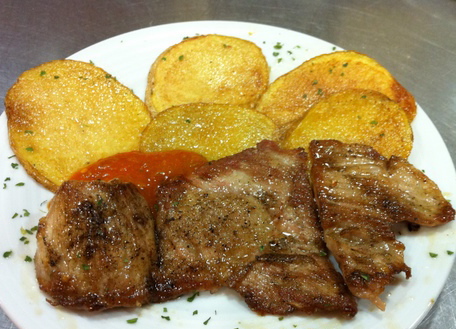Pá de Porco -Rubbing shoulders in Portugal
 |
| Pá de Porco Assada |
When I made the decision to make Portugal my permanent home a close friend of mine gave me this advice."Estrangeiros" in Portugal we are and "Estrangeiros" we will always be. We remain guests in this country and should respect this at all times.How right she was. In 6 years of living In the Algarve I have not been aware of ever having rubbed anyone up the wrong way. When it comes to food however I can often be critical. One can absorb a nation´s culinary culture and take on board the traditions that come with it, but there are times when one has to agree to differ.I have never rubbed the lesser known shoulder of pork,but have been meaning to tackle it for along time.Recently a follower of this blog asked me if I could come up with a recipe for this particular cut.I found this recipe for spicy Portuguese garlic roasted pork, traditional of the Azores.This recipe is a common way of slow roasting pork in Portugal,using a marinade of hot chilli paste, garlic,and wine.
Slow cooking is the essence of this cut of pork so don´t think of attempting this for a mid-week supper.Plan this hearty roast for a leisurely day on a weekend, though, because it may take most of the afternoon to cook.The meat also requires to be marinated for 24 hours.My resulting roast was a little on the dry side and a little overcooked: I would assume this is how the Portuguese enjoy eating it, but I prefer my pork a little less done. I leave the rest up to you.Portuguese households are never without a jar of hot chilli paste. If you dont have a jar of home made paste to hand, choose your chillies and quantity thereof according to your own taste and what you have available.The quantity of paste this recipe yields will give you sufficient to keep a jar in the refrigerator after you have rubbed the pork for this particular recipe.Shoulder roasts are not tender cuts of pork, so they need to be roasted slowly. It is essential to keep the moisture in during cooking or cover the roast with aluminum foil.The roasting heat should be kept to between 300F and 350F degrees. Unlike loin roasts and tenderloins, which roast best without moisture added, shoulder roasts need the moisture to cook evenly and cook out their fat content. Use chicken stock or water in the bottom of the pan to ensure continuous circulation of moisture. Plan 40 to 50 minutes per pound for the top of the shoulder contains more fats and gristle that take longer to break down. A 4-lb. boneless shoulder will take from 3 hours to 3 hours and 20 minutes.The lower part of the shoulder needs 35 to 40 minutes per pound to roast properly. All cooking times can only be approximate because each roast varies in fat content and composition; always check your roast with a meat thermometer to make sure that its inner temperature has reached 170 degrees before taking it out to "rest." It will continue cooking for a few minutes after being taken out of the oven.
Spicy Portuguese Roast shoulder of pork
( Pá de Porco Assada )
serves 8
Six to eight jalapeno chillis /malaguetas deseeded, or 50g piri piri chillies
de-seeded and chopped
1/2 cup garlic
Tablespoon Flor de sal
3 tablespoons Sweet paprika
1/2 cup dry white wine
2 tablespoons ( 1 small tin) tomato puree
1/4 cup olive oil
4 to 5 pound cut boneless pork shoulder
2 cups chicken stock
Combine the chillies, garlic, flor de sal and paprika in a food processor and pulse until a paste is formed. Add the wine,olive oil and tomato puree and process again.
Using a sharp paring knife cut deep slits all over the pork to allow the paste to penetrate the meat. Rub the paste vigorously all over the pork and cover with plastic film. Leave to marinate in the fridge for 24 hours turning occasionally.
Preheat the oven to 350F and bring meat to room temperature.
Transfer the meat to a roasting pan large enough to take the meat.
Add the chicken stock to the roasting pan,it should come about one inch up the sides of the roasting pan.
Transfer to the oven.Roast the meat for 1 hour turning occasionally or until browned on all sides.Add more water to the roasting pan at periodic intervals if necessary to ensure pork drippings do not burn on the bottom of the pan.Reduce the oven temperature to 300F and continue cooking for a further 1.5 hours or until the meat is fork tender.Set aside the meat to rest for 15 minutes.Using a spoon skim as much fat from the surface of the drippings as possible.
Serve with tomato and sage beans, Roast potatoes or Portuguese rice.


Nice recipe, thanks
ReplyDelete